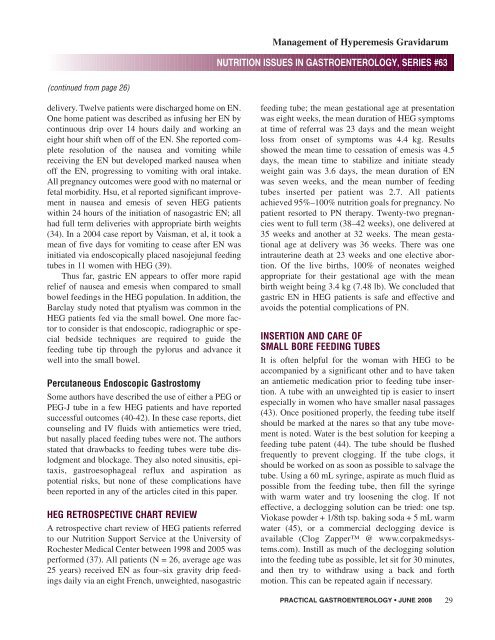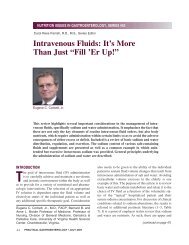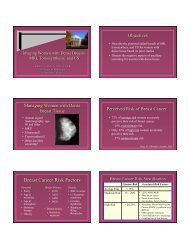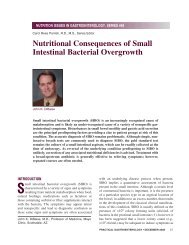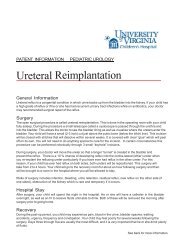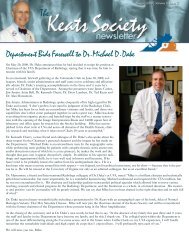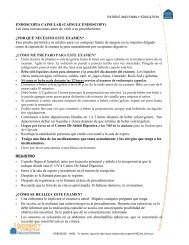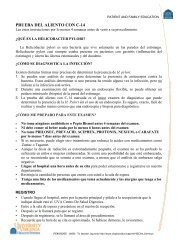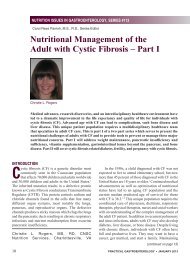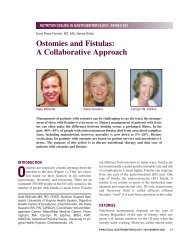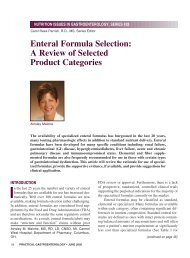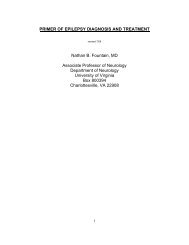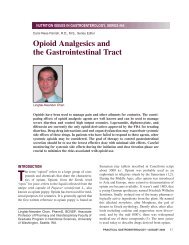Management of Hyperemesis Gravidarum with Enteral ... - Medicine
Management of Hyperemesis Gravidarum with Enteral ... - Medicine
Management of Hyperemesis Gravidarum with Enteral ... - Medicine
You also want an ePaper? Increase the reach of your titles
YUMPU automatically turns print PDFs into web optimized ePapers that Google loves.
(continued from page 26)<br />
delivery. Twelve patients were discharged home on EN.<br />
One home patient was described as infusing her EN by<br />
continuous drip over 14 hours daily and working an<br />
eight hour shift when <strong>of</strong>f <strong>of</strong> the EN. She reported complete<br />
resolution <strong>of</strong> the nausea and vomiting while<br />
receiving the EN but developed marked nausea when<br />
<strong>of</strong>f the EN, progressing to vomiting <strong>with</strong> oral intake.<br />
All pregnancy outcomes were good <strong>with</strong> no maternal or<br />
fetal morbidity. Hsu, et al reported significant improvement<br />
in nausea and emesis <strong>of</strong> seven HEG patients<br />
<strong>with</strong>in 24 hours <strong>of</strong> the initiation <strong>of</strong> nasogastric EN; all<br />
had full term deliveries <strong>with</strong> appropriate birth weights<br />
(34). In a 2004 case report by Vaisman, et al, it took a<br />
mean <strong>of</strong> five days for vomiting to cease after EN was<br />
initiated via endoscopically placed nasojejunal feeding<br />
tubes in 11 women <strong>with</strong> HEG (39).<br />
Thus far, gastric EN appears to <strong>of</strong>fer more rapid<br />
relief <strong>of</strong> nausea and emesis when compared to small<br />
bowel feedings in the HEG population. In addition, the<br />
Barclay study noted that ptyalism was common in the<br />
HEG patients fed via the small bowel. One more factor<br />
to consider is that endoscopic, radiographic or special<br />
bedside techniques are required to guide the<br />
feeding tube tip through the pylorus and advance it<br />
well into the small bowel.<br />
Percutaneous Endoscopic Gastrostomy<br />
Some authors have described the use <strong>of</strong> either a PEG or<br />
PEG-J tube in a few HEG patients and have reported<br />
successful outcomes (40-42). In these case reports, diet<br />
counseling and IV fluids <strong>with</strong> antiemetics were tried,<br />
but nasally placed feeding tubes were not. The authors<br />
stated that drawbacks to feeding tubes were tube dislodgment<br />
and blockage. They also noted sinusitis, epitaxis,<br />
gastroesophageal reflux and aspiration as<br />
potential risks, but none <strong>of</strong> these complications have<br />
been reported in any <strong>of</strong> the articles cited in this paper.<br />
HEG RETROSPECTIVE CHART REVIEW<br />
A retrospective chart review <strong>of</strong> HEG patients referred<br />
to our Nutrition Support Service at the University <strong>of</strong><br />
Rochester Medical Center between 1998 and 2005 was<br />
performed (37). All patients (N = 26, average age was<br />
25 years) received EN as four–six gravity drip feedings<br />
daily via an eight French, unweighted, nasogastric<br />
<strong>Management</strong> <strong>of</strong> <strong>Hyperemesis</strong> <strong>Gravidarum</strong><br />
NUTRITION ISSUES IN GASTROENTEROLOGY, SERIES #63<br />
feeding tube; the mean gestational age at presentation<br />
was eight weeks, the mean duration <strong>of</strong> HEG symptoms<br />
at time <strong>of</strong> referral was 23 days and the mean weight<br />
loss from onset <strong>of</strong> symptoms was 4.4 kg. Results<br />
showed the mean time to cessation <strong>of</strong> emesis was 4.5<br />
days, the mean time to stabilize and initiate steady<br />
weight gain was 3.6 days, the mean duration <strong>of</strong> EN<br />
was seven weeks, and the mean number <strong>of</strong> feeding<br />
tubes inserted per patient was 2.7. All patients<br />
achieved 95%–100% nutrition goals for pregnancy. No<br />
patient resorted to PN therapy. Twenty-two pregnancies<br />
went to full term (38–42 weeks), one delivered at<br />
35 weeks and another at 32 weeks. The mean gestational<br />
age at delivery was 36 weeks. There was one<br />
intrauterine death at 23 weeks and one elective abortion.<br />
Of the live births, 100% <strong>of</strong> neonates weighed<br />
appropriate for their gestational age <strong>with</strong> the mean<br />
birth weight being 3.4 kg (7.48 lb). We concluded that<br />
gastric EN in HEG patients is safe and effective and<br />
avoids the potential complications <strong>of</strong> PN.<br />
INSERTION AND CARE OF<br />
SMALL BORE FEEDING TUBES<br />
It is <strong>of</strong>ten helpful for the woman <strong>with</strong> HEG to be<br />
accompanied by a significant other and to have taken<br />
an antiemetic medication prior to feeding tube insertion.<br />
A tube <strong>with</strong> an unweighted tip is easier to insert<br />
especially in women who have smaller nasal passages<br />
(43). Once positioned properly, the feeding tube itself<br />
should be marked at the nares so that any tube movement<br />
is noted. Water is the best solution for keeping a<br />
feeding tube patent (44). The tube should be flushed<br />
frequently to prevent clogging. If the tube clogs, it<br />
should be worked on as soon as possible to salvage the<br />
tube. Using a 60 mL syringe, aspirate as much fluid as<br />
possible from the feeding tube, then fill the syringe<br />
<strong>with</strong> warm water and try loosening the clog. If not<br />
effective, a declogging solution can be tried: one tsp.<br />
Viokase powder + 1/8th tsp. baking soda + 5 mL warm<br />
water (45), or a commercial declogging device is<br />
available (Clog Zapper @ www.corpakmedsystems.com).<br />
Instill as much <strong>of</strong> the declogging solution<br />
into the feeding tube as possible, let sit for 30 minutes,<br />
and then try to <strong>with</strong>draw using a back and forth<br />
motion. This can be repeated again if necessary.<br />
PRACTICAL GASTROENTEROLOGY • JUNE 2008 29


